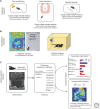Quantifying Sex Differences in Behavior in the Era of "Big" Data
- PMID: 34607831
- PMCID: PMC9159265
- DOI: 10.1101/cshperspect.a039164
Quantifying Sex Differences in Behavior in the Era of "Big" Data
Abstract
Sex differences are commonly observed in behaviors that are closely linked to adaptive function, but sex differences can also be observed in behavioral "building blocks" such as locomotor activity and reward processing. Modern neuroscientific inquiry, in pursuit of generalizable principles of functioning across sexes, has often ignored these more subtle sex differences in behavioral building blocks that may result from differences in these behavioral building blocks. A frequent assumption is that there is a default (often male) way to perform a behavior. This approach misses fundamental drivers of individual variability within and between sexes. Incomplete behavioral descriptions of both sexes can lead to an overreliance on reduced "single-variable" readouts of complex behaviors, the design of which may be based on male-biased samples. Here, we advocate that the incorporation of new machine-learning tools for collecting and analyzing multimodal "big behavior" data allows for a more holistic and richer approach to the quantification of behavior in both sexes. These new tools make behavioral description more robust and replicable across laboratories and species, and may open up new lines of neuroscientific inquiry by facilitating the discovery of novel behavioral states. Having more accurate measures of behavioral diversity in males and females could serve as a hypothesis generator for where and when we should look in the brain for meaningful neural differences.
Copyright © 2022 Cold Spring Harbor Laboratory Press; all rights reserved.
Figures

References
-
- Bernstein IS. 1991. An empirical comparison of focal and ad libitum scoring with commentary on instantaneous scans, all occurrence and one-zero techniques. Anim Behav 42: 721–728. 10.1016/S0003-3472(05)80118-6 - DOI
